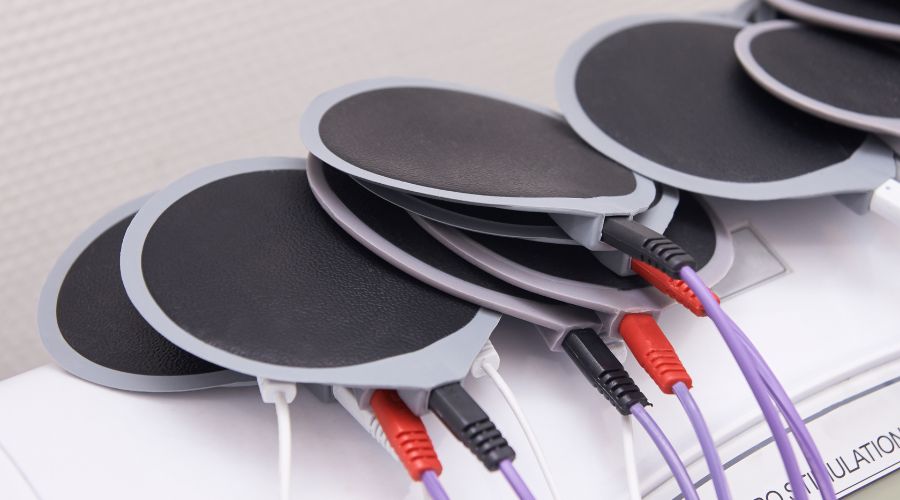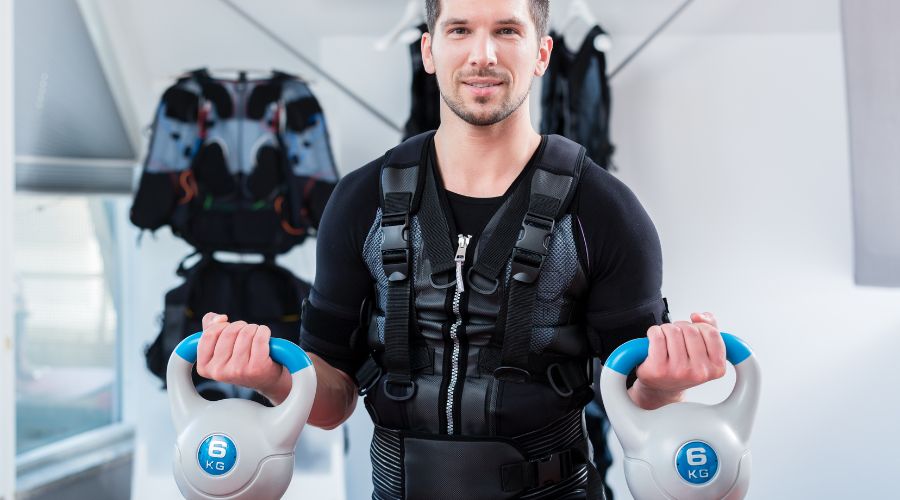Electrical Muscle Stimulation (EMS) offers a versatile solution for improving your fitness, activating your muscles, speeding up recovery, and easing everyday muscle discomfort. In the past, EMS was mainly used by healthcare professionals, like doctors and physical therapists. But now, it’s accessible to a wider audience, including professional trainers, athletes, and fitness enthusiasts, making it more popular than ever. In this blog post, we’re going to explore Electrical Muscle Stimulation (EMS).
We’ll discover some interesting facts, see where it’s used, and understand its benefits. We’ll also delve into the science behind EMS, make it easy to understand, and show you how you can integrate it into your daily or weekly workout routine for improved results. So, let’s get started on this journey to explore the world of EMS and how it can enhance your fitness and well-being.
1. What is Electrical Muscle Stimulation (EMS)?

Electrical Muscle Stimulation (EMS) is a technique that harnesses the power of electrical impulses to trigger muscle contractions. It’s like giving your muscles a workout without physically moving them. EMS involves using special devices that send controlled electrical signals through the skin. These electrical impulses are directed to specific nerves or muscles. When the impulses reach these areas, they stimulate the nerves, which, in turn, cause the associated muscles to contract. This mimics the natural process of muscles contracting and releasing when you exercise or perform various physical activities.
In simpler terms, EMS essentially sends an electric signal to your brain, telling it to activate certain muscles. As a result, these muscles contract just as they would during traditional exercise or movement. This process is designed to help tone and strengthen the muscles, making it a valuable tool for fitness and rehabilitation.
In addition to EMS, another well-known electrical stimulation technique is TENS (Transcutaneous Electrical Nerve Stimulation), which is primarily used for pain relief. TENS devices work by using mild electrical currents to “close the pain gate” in your brain, reducing the feeling of pain. They can also trigger your body to release natural painkillers called endorphins. TENS helps by interfering with pain signals travelling along your nerves.
Now, how are TENS different from EMS (Electrical Muscle Stimulation)? Well, it mainly focuses on making your muscles contract, along with EMS muscle recovery which is great for strengthening muscles, and fitness, while TENS is all about managing pain and doesn’t really work on your muscles.
2. Discovery And History Of Electrical Muscle Stimulation (EMS)

Electrical Muscle Stimulation (EMS) has a long and fascinating history dating back to around 500 BC, when the ancient Egyptians discovered that electric fish could be used to treat pain. This knowledge was later embraced by the Greeks and Romans, who used electric fish to treat various ailments. In the 19th century, EMS began to take a more structured form and was used effectively to treat motor paralysis. The 20th century saw significant innovations in EMS devices, though they were initially bulky and sometimes produced unpleasant effects. As the medical understanding of electrical impulses deepened, physicians increasingly incorporated EMS into their treatments, resulting in its advancement into a valuable tool for fitness, rehabilitation, and medical therapy in the present day.
3. Here’s How It Works

EMS involves the application of tiny electrodes to the skin. These electrodes are little, sticky pads that are easily removed at the end of the session. The process of Electrical Muscle Stimulation (EMS) involves the placement of electrodes or pads around the area being treated. These electrodes are connected to wires, which, in turn, are attached to the EMS device. This device can vary in size, with some being small and handheld, while others can be larger.
When using EMS for muscular stimulation, the device sends out steady streams of electrical pulses through the attached wires and electrodes. These electrical pulses reach the muscles, effectively signalling them to contract. It’s similar to the natural process that occurs when your brain sends signals to your muscles during physical activity or exercise. The controlled contractions induced by EMS can help strengthen and tone the targeted muscles.
4. What Are the Benefits of Electrical Muscle Stimulation?

Improved Muscle Performance
You can attain better muscle performance by using EMS, which maximises muscle contractions. Increased strength, power, and endurance are benefits of activating a larger percentage of muscle fibres, and these qualities can be especially helpful for athletes and anyone who wants to challenge their physical boundaries.
Muscle Strength & Growth
EMS is a powerful tool for increasing muscle strength and encouraging muscle development. It may be used to target specific muscle groups, making it great for people looking to develop specific portions of their physique.
Improve Blood Circulation
Electrical stimulation improves blood flow to the treated area, allowing oxygen and nutrients to reach the muscles. This can help you recover faster after an exercise and lessen the danger of muscle fatigue and cramps.
Reduced Muscle Soreness
Using EMS post-workout can help reduce the severity and duration of muscle soreness. It promotes quicker recovery, allowing you to engage in subsequent training sessions with less discomfort.
Prevention of Muscle Atrophy
EMS can assist in avoiding muscle atrophy in people who have limited movement or are bedridden. It preserves muscle mass, strength, and functionality by activating the muscles on a regular basis.
Muscle Toning and Sculpting
Because EMS is a useful technique for toning and sculpting muscles, it is popular among people aiming for a more aesthetically pleasing physique. It can help with muscle definition and body contouring.
Efficient Workouts
EMS is well-known for its speed. It can provide a comprehensive full-body workout in less time than traditional exercise, saving time for busy people while producing noticeable effects.
Injury Prevention and Rehabilitation
EMS can help with injury prevention and rehabilitation. It gently stimulates muscles, boosting circulation and strength, lowering the chance of re-injury, and aiding in the recovery process when used in a controlled manner.
Body Shaping and Fat Reduction
EMS, when combined with a balanced diet and regular exercise, can contribute to body shaping, calorie burning, and fat reduction. It enhances muscle toning, which, in turn, can boost metabolic rate, potentially resulting in a reduction of body fat.
Pain Relief for Chronic Conditions
EMS can be a helpful treatment option for chronic pain problems such as fibromyalgia and chronic back pain. It modifies pain signals and promotes the release of natural pain-relieving compounds in the body, providing relief to people suffering from chronic pain.
5. What Are the Risks Associated With EMS?

Electrical Muscle Stimulation (EMS) is generally considered safe, but there are a few potential risks that you should be aware of:
Tissue Burns and Skin Irritation: Sometimes, EMS can cause burns or skin irritation if the pads are not placed properly or if the intensity is too high. So it is crucial to follow the instructions carefully to avoid it.
Don’t Mix with Medication Patches: If you have a medication patch on your skin, be careful with EMS. It can interfere with the medication, so keep the electrodes away from the patch.
Not for Everyone: EMS might not be suitable for everyone, such as:
- Pregnant People: We’re not sure how EMS affects pregnancies, so it’s best to avoid it unless your doctor says it’s okay.
- People with Pacemakers: If you have a pacemaker, EMS could mess with it. So, you should steer clear unless your doctor recommends it.
- People with Epilepsy: EMS can potentially trigger seizures in people with epilepsy. It’s important to talk to your doctor first if you have epilepsy.
6. EMS System For Fitness Goals: How It Works

The Electrical Muscle Stimulation (EMS) system is like having a personalised fitness partner that’s designed to make your workouts more efficient. It does this by giving your metabolism a boost and enhancing your workout experience, all while saving you time. It’s a fantastic tool for those looking to shed extra weight and achieve faster results. When you use EMS, you put on a special vest and straps on your arms, legs, and glutes. These straps gently send small electrical signals to your muscles, and don’t worry, it feels completely painless and safe.
An EMS training system incorporating an EMS device or suit has the ability to transform your light workout into a highly effective one. By engaging deep-seated muscles that regular exercises often overlook, EMS helps you achieve better results. It does this in two ways. Firstly, it activates all your muscles, including the ones you usually don’t engage with traditional workouts. Secondly, it targets those fast-twitch muscles that are usually difficult to stimulate. This means your workouts become incredibly efficient at building muscle and increasing your overall strength.
7. Who’s Using EMS Technology and Why?

EMS technology has grown in popularity, with a wide range of people turning to it for a variety of reasons. While top-level athletes have been utilising EMS for years, recently, a broader audience, including celebrities, CEOs, and fitness enthusiasts, has jumped on this fitness trend, and it’s not hard to see why. For instance, traditional exercises like crunches, lunges, or dumbbell curls target one muscle at a time with each movement. In contrast, electrical muscle stimulation (EMS) takes a different approach, promoting hundreds of muscle contractions per second. This efficiency is a game-changer, perfect for those seeking an efficient and effective way to achieve their fitness goals. EMS offers a compelling option for those who want to maximise their workouts, save time, and achieve results more quickly.
Conclusion
Electrical Muscle Stimulation (EMS) is a versatile and effective method that uses electrical impulses to activate muscles, promoting blood flow and strength. Originally a key component of physical therapy, it has expanded its reach, becoming a valuable tool for enhancing workouts, muscle endurance, and achieving fitness goals. With its efficient results, EMS has gained popularity among athletes, fitness enthusiasts, and even celebrities. Its ability to stimulate deep muscles and improve circulation makes it a compelling choice for rehabilitation and overall well-being.
EMS has evolved from a specialised therapy technique to a multifaceted approach that contributes to a wide range of fitness and health objectives. So, whether you’re an athlete looking to enhance your performance, someone recovering from an injury, or just want to improve your muscle strength, EMS can be a useful addition to your fitness routine. It offers a way to engage your muscles effectively, even when you’re not actively working out.


